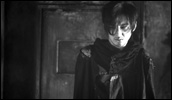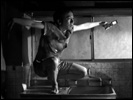Nightmare Detective
- Year
- 2006
- Original title
- Akumu Tantei
- Japanese title
- 悪夢探偵
- Director
- Cast
- Running time
- 106 minutes
- Published
- 21 October 2007



by Nicholas Rucka
About two years ago I was having a hell of a time writing a review for Midnight Eye on Shinya Tsukamoto's short film HAZE and I eventually abandoned it. For some reason, I was having a hard time getting a handle on what had changed in the filmmaking style of the industrial avant-garde director's work.
Up until this point, Shinya Tsukamoto had pretty much made a small cottage industry for himself out of the literal and figurative incompatibility of flesh and metal and its explosive results. With a genesis dating back long before his debut feature Tetsuo, which was a churlish response to bubble era growth at all costs and the dehumanizing of the individual into a fungible cog within the Japanese economic miracle machine, this machine/body metaphor had somehow still proved to be surprisingly appropriate for the post-bubble, recession-era soul searching of the 1990s.
With one or two notable commercial exceptions Shinya Tsukamoto's works have been intensely personal pieces that operate with a brushed metal lyricism and poetry that demands the audience either commit entirely to the 'art' and metaphor depicted on screen or else buzz off - put simply, these aren't movies for everyone. For me, seeing a new Shinya Tsukamoto film was always a hotly anticipated experience because I knew it was going to surprise and subvert my expectations and, come what may, I was guaranteed to exit the theater with a profound perspective shift. (Perhaps the best Western analog of this would be watching early David Lynch or David Cronenberg films? If so, then perhaps it's no accident that much of the international advertising attached to Shinya Tsukamoto's films often contain a Lynch or David Cronenberg parallel: "Japan's answer to David Cronenberg!" proclaims a UK one-sheet for Tetsuo: The Iron Man.)
In 2004, Shinya Tsukamoto's film Vital, starring Tadanobu Asano, was the first sign for me that something had dramatically changed in Tsukamoto's works. The obvious movement away from the man/machine theme to one of memory and the subjective nature of perception was the culprit; but somehow it felt like Tsukamoto didn't know what to do with this... thing... he was trying to birth. For once, there appeared to be something unusually imprecise and cobbled-together about the filmmaking, the theme, and the overall statement he was trying to make. That said, there were wonderful moments of filmmaking including the stunning black and white photography of oil in water as well as the cool color shots of the corpses covered by white sheets in the dilapidated medical school.
I took this as a sign that, yes, Shinya Tsukamoto was still behind it all, but somehow I couldn't reconcile the random introduction of a modern dance scene performed on an Okinawan beach and shot in a bright, yet somehow flat color scheme. This part felt like an orphan scene from Spike Lee's She's Gotta Have It and not something from a Shinya Tsukamoto film. I was beginning to worry that Shinya Tsukamoto was becoming lazy and more impulsive and imprecise as a filmmaker.
Nightmare Detective has made me reconsider that notion.
In Nightmare Detective, a series of gruesome and mysterious apparent suicides prompts a female detective (Hitomi) to investigate. She discovers that the common denominator in all cases was the fact that the victims had dialed Zero on their phones before they died. All signs from the investigation indicates that something supernatural is occurring and when the detective suspects it has something to do with the nightmare world, she convinces a young social outcast (Matsuda) with the ability to enter dreams to aid in her investigation. What he discovers in the gray, seemingly permanently solar-eclipsed nightmare world is a negative reality where metaphor can be a deadly weapon. This is the home of Zero (Shinya Tsukamoto), a merchant of death who feasts on the misery and demise of the living.
Up until this point Shinya Tsukamoto has been defiantly self-reliant. An indication of his theater group DIY roots, he often wrote, shot, performed in, directed, edited, and art directed (etc.) just about every one of his films. This total presence gives his works a unique thumbprint that invariably makes his films immediately recognizable as a Shinya Tsukamoto (Kaiju Theater) production. So it's for this reason, perhaps more than for any other director currently working in Japan, when there's a change in his overall filmmaking approach, the differences ripple through his work like shockwaves.
I should know by now that filmmakers (like all artists), in an effort to grow, experiment with their craft - even without being able to fully articulate why they are doing it - and then build off of their experiences. It turns out that this is exactly what Shinya Tsukamoto has been up to in his last few films: he's been in the lab, and for better or for worse we've been able to see what he's been cooking up.
It turns out that the creepy photography of the operating theater in Vital ended up informing the nightmare world photography in Nightmare Detective, just as Haze's man locked in a concrete box in various stomach churning stress positions reappears as Zero's nightmare world in Nightmare Detective. Perhaps what surprised me the most is that I wouldn't have expected Tsukamoto to have collected his previous experiments together in what is arguably his most conventional film (after Hiruko the Goblin and, perhaps, Gemini). But what makes Nightmare Detective such an exciting film (particularly for the Tsukamoto fan) is that Tsukamoto has somehow manufactured his most commercial film to date while retaining his experimental/industrial filmmaking integrity. This film isn't a product of sell-out commercialism, but one that somehow feels like a work of a matured filmmaker who is not afraid to approach traditional storytelling techniques as viewed through his aesthetic. As an audience we've lucked out, it's a thrilling and bewitching world that avoids traditional scares in favor of a low humming tension that hangs with us long after we finish watching the film.
Nightmare Detective's opening day in Shibuya was a sold-out affair predominantly attended by fashionably dressed young women in their late teens and early twenties. This is not the demographic that one would expect at a Shinya Tsukamoto film, but with both pop idol Hitomi and young heartthrob Ryuhei Matsuda starring in it, it's not entirely unexpected. What's exciting, though, is that Nightmare Detective has connected with a new generation of film-goers, a young audience that was born about the time that Tetsuo was first unleashed in Japanese theaters. Could we call this film-going generation the Tetsuo generation? I wouldn't go so far, but Tsukamoto's influence on Japanese pop-culture has been massive and he can even occasionally be found on TV variety shows representing the 'artist'. All this would seem to indicate that Tsukamoto's aesthetic has finally come of age, having this time found a perfect pairing with pop-horror stories.
Watching the crowd pour out of the Shibuya theater talking excitedly about how much they liked the film made me think that Shinya Tsukamoto, himself a Shibuya native (he was born and grew up there), had finally found the secret to popular success that had long proved elusive. Despite all of the smoke-stack grays and engine-grease blacks that filled out the nightmare palette in the film, the 'Zero' in Nightmare Detective was finally having his day in the sun. It was a nice thing to witness.